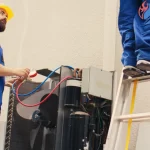The Ultimate Guide to AC Installation Services: What You Need to Know
When the sweltering heat of summer arrives, having a reliable and efficient air conditioning system in your home becomes a necessity. If you’re considering getting a new AC system or upgrading your existing one, it’s crucial to understand the ins and outs of AC installation services. This comprehensive guide will walk you through everything you need to know about AC installation, ensuring that you make informed decisions to keep your home cool and comfortable.
Why is AC Installation Important?
The Role of Air Conditioning in Home Comfort
Air conditioning plays a vital role in maintaining a comfortable indoor environment, especially during the scorching summer months. It helps regulate temperature, control humidity, and improve indoor air quality. A well-installed AC system can make your home a haven of comfort and relief when outdoor temperatures are soaring.
Types of AC Systems
Before diving into the installation process, it’s essential to understand the different types of air conditioning systems available. Each type has its own characteristics and advantages, so choosing the right one depends on your specific needs and circumstances.
Central Air Conditioning
Central air conditioning is a common choice for cooling larger homes. It consists of a central cooling unit (usually located outdoors) connected to ductwork that distributes cool air throughout the house. Central AC is known for its even cooling and ability to maintain consistent temperature levels.
Ductless Mini-Split Systems
Ductless mini-split systems offer flexibility and energy efficiency. They consist of an outdoor unit connected to one or more indoor air handlers. These systems don’t require ductwork and can be installed in individual rooms or zones, allowing for precise temperature control.
Window Units
Window air conditioners are a cost-effective option for cooling single rooms. They are easy to install by placing them in a window or a specially designed opening in a wall. These units are suitable for smaller spaces and are relatively simple to operate.
Portable AC Units
Portable air conditioners are similar to window units but can be moved from room to room. They require an exhaust hose to vent hot air outside through a window or opening. Portable AC units are ideal for cooling specific areas on a temporary basis.
Choosing the Right AC System
Selecting the right AC system for your home involves considering various factors to ensure it meets your cooling needs and budget. Here are some key considerations:
Determining Your Cooling Needs
The size and layout of your home, as well as your climate zone, play a significant role in determining the capacity (measured in British Thermal Units or BTUs) your AC system should have. An oversized AC unit may cycle on and off frequently, leading to energy inefficiency, while an undersized unit won’t adequately cool your space.
To determine your cooling needs, you can seek assistance from a professional HVAC technician who can perform a load calculation. This calculation takes into account factors such as:
- Home size and layout
- Insulation levels
- Number and size of windows and doors
- Local climate conditions
- Heat-producing appliances and electronics
Energy Efficiency Considerations
Energy efficiency is a critical factor in choosing an AC system, as it can significantly impact your long-term energy bills. Look for systems with high SEER (Seasonal Energy Efficiency Ratio) ratings. Higher SEER ratings indicate greater efficiency. Energy-efficient systems may qualify for energy rebates or incentives in your area, further offsetting installation costs.
Budget Considerations
Your budget will inevitably influence your choice of AC system. While it’s tempting to opt for the cheapest option, it’s essential to strike a balance between upfront costs and long-term energy savings. Keep in mind that investing in a more energy-efficient system may pay off in the form of lower utility bills over time.
Sizing Your AC Unit
Selecting the right size for your AC unit is crucial for efficient cooling and long-term performance. Installing an incorrectly sized unit can lead to a range of problems, including inadequate cooling, high energy bills, and premature wear and tear on the system.
The Importance of Proper Sizing
Proper sizing ensures that your AC unit can effectively cool your home without running constantly or cycling on and off frequently. Both scenarios can lead to inefficiency, discomfort, and potential damage to the equipment.
Factors Affecting AC Unit Size
Several factors influence the size of the AC unit you’ll need:
- Home Size: Larger homes typically require larger capacity units. However, it’s essential to consider factors like insulation and room layout.
- Climate: The climate in your region plays a role in determining your cooling load. Hotter climates may require more significant cooling capacity.
- Insulation: Well-insulated homes are more energy-efficient and may require a smaller AC unit to achieve the desired cooling.
- Windows and Doors: The number, size, and orientation of windows and doors affect heat gain in your home. South- or west-facing windows, for example, may require extra cooling capacity.
- Heat-Producing Appliances: Appliances like ovens, stoves, and refrigerators generate heat and contribute to your cooling load.
It’s advisable to consult with an HVAC professional who can perform a load calculation specific to your home to determine the appropriate AC unit size.
Selecting the Right Location
Proper placement of your AC unit and components is critical for efficient operation and cooling distribution. Here are some considerations for selecting the right location:
Indoor Unit Placement
For central air conditioning systems, the indoor unit, often referred to as the air handler or evaporator coil, is typically located in the basement, attic, or a dedicated utility room. It should be placed where it can distribute cool air evenly throughout the house. Proper placement minimizes the length of ductwork required, improving efficiency.
Outdoor Unit Placement
The outdoor unit, known as the condenser unit, should be positioned in a location that allows for optimal airflow. It should have adequate clearance on all sides to ensure proper ventilation and heat dissipation. Avoid placing it in direct sunlight or near obstructions that can impede airflow.
Ventilation and Airflow Considerations
Proper ventilation around the condenser unit is essential to prevent overheating. Ensure that there are no obstacles or debris blocking the airflow around the unit. Additionally, the condenser should be positioned on a level surface to prevent vibrations and reduce noise.
AC Installation Process
The AC installation process involves several crucial steps to ensure that your system operates efficiently and effectively. Here’s an overview of what you can expect during the installation:
Pre-Installation Inspection
Before beginning the installation, the HVAC technician will perform a thorough inspection of your home. This includes evaluating your current HVAC system (if applicable), checking the condition of your ductwork (for central systems), and assessing the electrical system to ensure it can handle the new AC unit.
Ductwork Evaluation (For Central Systems)
If you’re installing a central air conditioning system, the technician will inspect your existing ductwork. Any leaks, gaps, or damage in the ducts will be addressed to ensure optimal airflow and energy efficiency. If necessary, the technician may recommend duct sealing or replacement.
Electrical Requirements
Your home’s electrical system must meet the requirements of the new AC unit. This may involve upgrading the electrical panel or circuit to accommodate the additional load. It’s crucial to have a qualified electrician handle any electrical work to ensure safety and compliance with local codes.
Refrigerant Lines and Connections
The installation team will connect the refrigerant lines between the indoor and outdoor units, ensuring a secure and leak-free connection. Proper refrigerant charge is critical for efficient cooling, so technicians will carefully measure and adjust the refrigerant levels.
DIY vs. Professional Installation
When it comes to AC installation, you might be considering the option of a DIY installation to save money. While this is possible for some individuals with the necessary skills and experience, there are significant advantages to hiring a professional HVAC contractor.
Pros and Cons of DIY Installation
Pros:
- Cost Savings: DIY installation can save you money on labor costs.
- Control: You have complete control over the installation process.
Cons:
- Lack of Expertise: DIYers may lack the knowledge and experience to install the system correctly, leading to inefficiencies, safety hazards, and potential damage to the equipment.
- Warranty Issues: Manufacturers often require professional installation to maintain warranty coverage. If you install the system yourself, you may void the warranty.
- Safety Risks: Handling refrigerants and electrical components can be dangerous without the proper training and equipment.
Benefits of Professional Installation
1. Expertise: Professional HVAC technicians have the training and experience to install AC systems correctly, ensuring optimal performance and efficiency.
2. Warranty Coverage: Many manufacturers require professional installation to validate the warranty on your AC system. Without professional installation, you may void the warranty.
3. Safety: AC installation involves handling electrical components and refrigerants, which can be dangerous without the proper training and equipment. Professionals prioritize safety during installation.
4. Efficiency: Professional installation maximizes the efficiency of your AC system, helping it cool your home more effectively and potentially saving you money on energy bills.
When weighing the pros and cons, it’s essential to consider your skill level and the complexity of the installation. If you’re unsure about any aspect of the installation process, it’s usually best to hire a professional to ensure a safe and reliable installation.
Ensuring Warranty Coverage
If you decide to have a professional installation, make sure to keep all documentation, including invoices and records of maintenance and service visits. This documentation may be required to validate the warranty on your AC system.
FAQs About AC Installation Services
Q1. How long does it take to install a central air conditioning system?
The duration of central air conditioning installation can vary, but it typically takes several days to a week or more. Factors that affect the timeline include the size of your home, the complexity of the installation, and any additional work required, such as ductwork modifications or electrical upgrades.
Q2. Can I install a window air conditioner myself?
Yes, many individuals choose to install window air conditioners themselves, as they are relatively straightforward to set up. However, it’s essential to follow the manufacturer’s instructions carefully and ensure that the unit is securely installed to prevent accidents and maintain efficiency.
Q3. How often should I have my AC system professionally inspected and serviced?
It’s recommended to have your AC system professionally inspected and serviced at least once a year, typically before the start of the cooling season. Regular maintenance helps identify and address issues early, improving efficiency and extending the system’s lifespan.
Q4. What is the SEER rating, and why is it important?
SEER stands for Seasonal Energy Efficiency Ratio, and it measures the energy efficiency of an air conditioning system. Higher SEER ratings indicate greater efficiency. Choosing an AC unit with a high SEER rating can lead to lower energy bills and reduced environmental impact.
Q5. Can I install a new AC unit in the winter?
Yes, you can install a new AC unit in the winter months. In fact, scheduling installation during the off-season may provide more flexibility in scheduling and potentially lower costs, as HVAC contractors tend to be less busy.
Best AC Installation Services
When it comes to your home’s cooling and comfort, making informed decisions about AC installation services is paramount. Whether you’re installing a new air conditioning system or upgrading your existing one, “AL Hadi AC Repair & Maintenance Services” is your trusted partner in ensuring that your journey towards a cooler and more comfortable home is smooth and hassle-free.
Remember that professional installation by “AL Hadi AC Repair & Maintenance Services” brings not only expertise but also safety, efficiency, and the assurance of warranty coverage. We pride ourselves on our commitment to quality and customer satisfaction, making us the go-to choice for AC installation, repair, and maintenance services.





Recent Comments